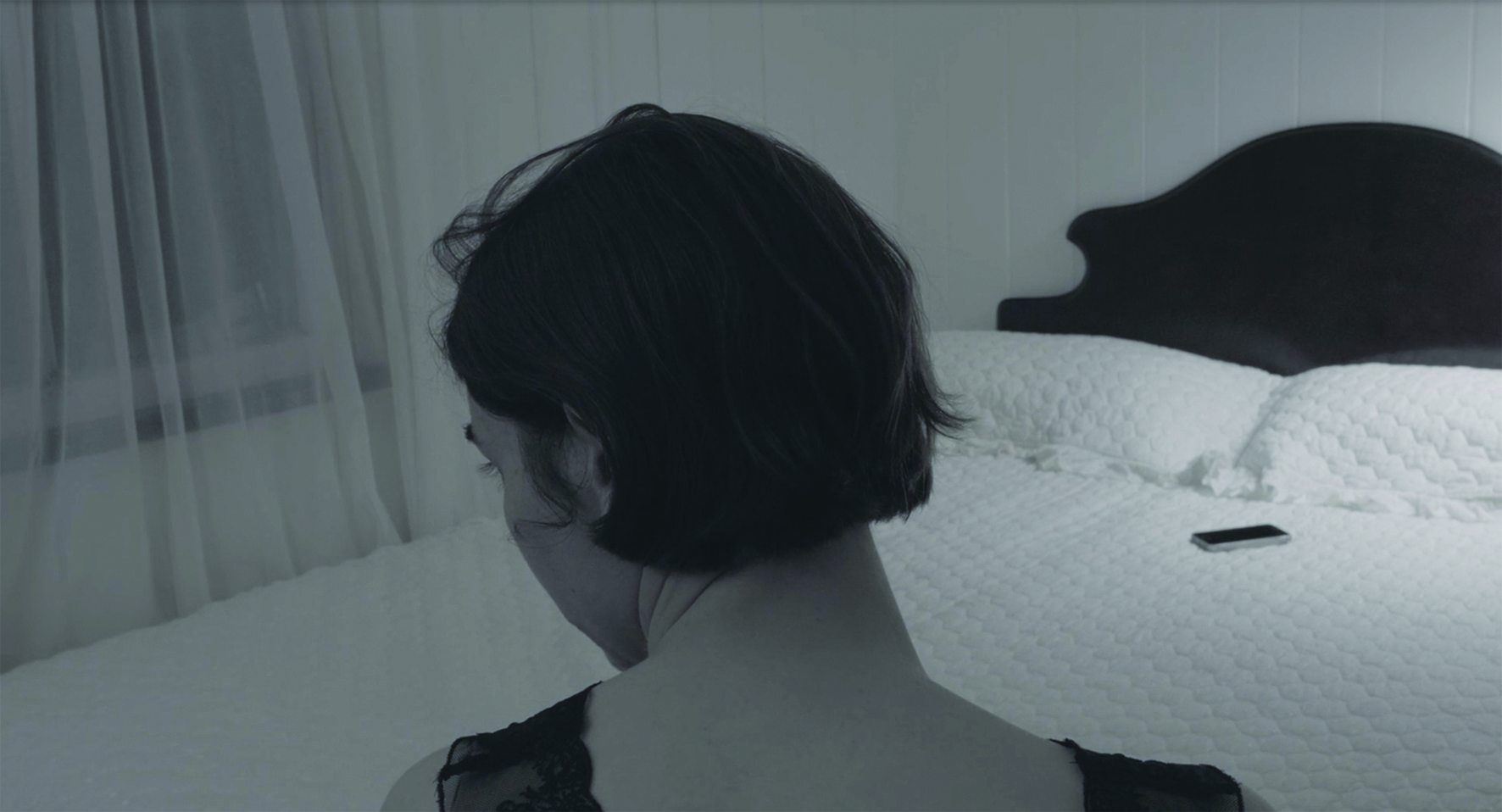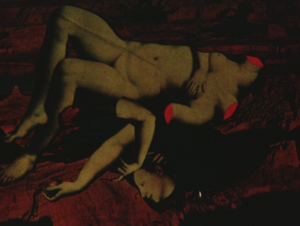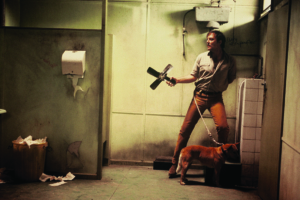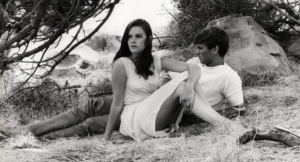A young woman, clad in loose white fabric, stands with her back to a wall, her attention devoted to the iPhone in her hand. Everything around her is sparse: a window faces onto the peeling weatherboard of the neighbouring property, its horizontal wooden slats contrasting with the vertically panelled interior. Nothing within the frame suggests the possibility of colour; only the woman’s achromatic skin definitively reveals the shot to be black-and-white.
This first, stationary, shot of Grace, Who Waits Alone (Georgia Temple, 2016), which lingers for over a minute, is both representative of one of the film’s recurring visual motifs – detached depictions of a human body and technological device encased together in mausoleum-like interiors – and indicative of its status as an underground film. Such rigorous minimalism has its antecedents in the international film canon (the cinema of Chantal Akerman, Jean-Marie Straub and Danièle Huillet, Mark Rappaport), but it is unlikely to be found nowadays among the slate of even the most adventurous independent picture houses, let alone the multiplexes. Certainly, it’s difficult to imagine a recent Australian production with any kind of theatrical release that looks like this.
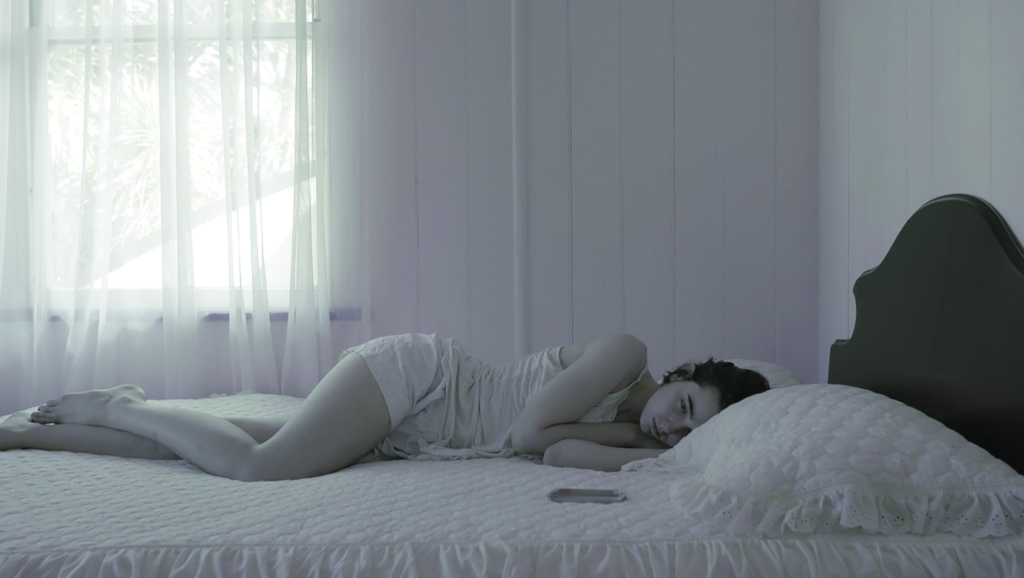
But then, this is a work that exists entirely beyond the realm of the local film industry. Shot over the course of two weeks for an estimated budget of A$1500[1]Georgia Temple, video interview with author, 3 February 2019. and featuring only one character (the titular protagonist, played by the director herself), Grace, Who Waits Alone has only had sporadic showings in Australia, most notably at the 2017 Queensland Film Festival. Other viewers, including this author, were first introduced to Temple’s feature in late 2018, at a single screening in a theatrette at the back of a cocktail bar in Melbourne’s inner north, a venue with a maximum capacity of thirty. It is no slight on the film to acknowledge that its potential audience reach is narrow. Indeed, if ever we were to apply the adjective ‘underground’ to an artwork, it’s hard to think of a case that could be more apt than a film like this.
What do we mean when we talk about underground film, though? For independent director and Senses of Cinema founder Bill Mousoulis, who organised the Melbourne screening of Grace, Who Waits Alone as part of a program entitled The Australian New Wave,[2]See Bill Mousoulis, ‘The Australian New Wave at Long Play, Melbourne, Nov 2018’, Pure Shit: Australian Cinema, 31 October 2018, <http://www.pureshitauscinema.com/new_wave_lp_18.html>, accessed 5 March 2019. the term may be loosely applied to filmmakers ‘who are actually making bold and formally inventive films’ but are ‘struggling to get noticed’.[3]Bill Mousoulis, email interview with author, 3 March 2019. He divides the broader Australian indie cinema scene into two streams: more ‘genre-oriented’ work – that is, those films that are able to achieve some exposure by slotting into the various B movie categories catered for by events such as the Melbourne Underground Film Festival (MUFF) and Monster Fest – and ‘no-budget’ art films, which are caught between a rock and a hard place: not trashy enough for the grindhouse circuit, but also frozen out of more highbrow platforms. These are titles that, for the most part, ‘the major film festivals won’t touch […] presumably because there’s no funding or distribution attached to them’.[4]ibid.
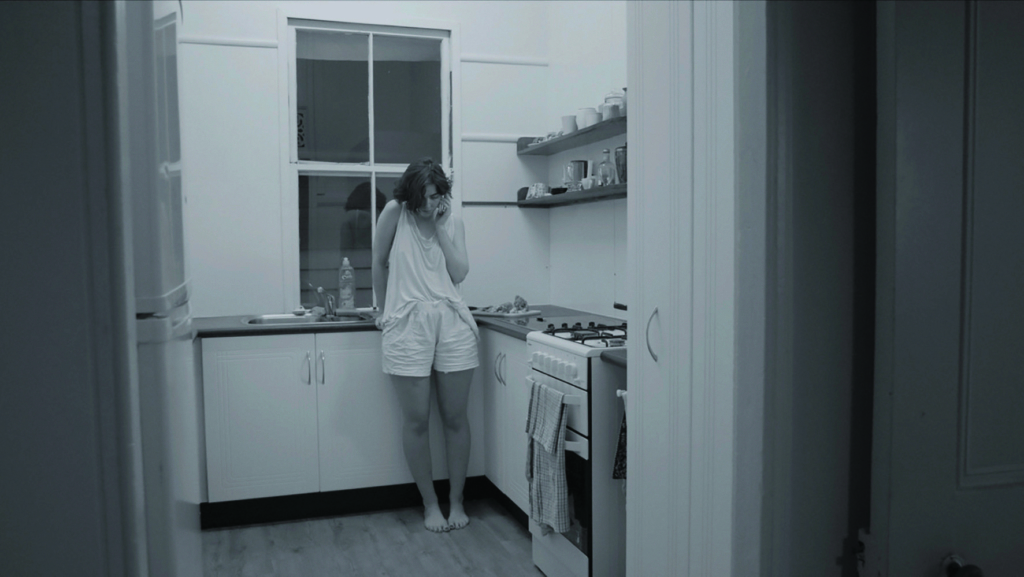
Underground film, in one form or another, has a rich history in Australia. Since the earliest days of modern Australian cinema, aesthetically daring works put together on a shoestring budget have existed alongside more popular, industry-backed fare. In the 1960s, even before the country had a film industry to speak of, filmmakers such as Giorgio Mangiamele in Melbourne and the Ubu collective in Sydney were making work that had more in common with European new wave and avant-garde movements than anything from the much-vaunted New Australian Cinema of the following decade,[5]See Alex Gerbaz, ‘The Legacy of the Experimental Film and Television Fund, 1970–78’, paper presented at the National Archives of Australia, Canberra, 13 October 2009, available at <http://www.naa.gov.au/collection/publications/papers-and-podcasts/social-history/gerbax-transcript.aspx>, accessed 5 March 2019. and Mousoulis traces this alternative canon of local cinema through the 1970s and 1980s to what he sees as a new resurgence today.[6]For a curated catalogue of some of these films, see Bill Mousoulis, ‘Online Indie Australian Cinema’, Pure Shit: Australian Cinema, <http://www.pureshitauscinema.com/online_cinema.html>, accessed 5 March 2019. But it’s clear that, even in comparison with the relatively niche work of overseas underground filmmakers like Akerman, Rappaport, Marcel Hanoun and Ulrike Ottinger, Australian underground films are little celebrated or even known in cinephile circles – in Australia or anywhere else. There’s a grim irony that this should be the case in a country whose broader cinematic output is so often treated with derision at home;[7]See Steve Dow, ‘What’s Wrong with Australian Cinema?’, The Guardian, 26 October 2014, <https://www.theguardian.com/film/2014/oct/26/australian-film-australian-audiences>, accessed 5 March 2019. it seems as if, rather than encouraging audiences to seek out alternative local creative voices, the cultural reluctance to attend industry-backed Australian films is only serving to bury their underground counterparts even more deeply.
Even in comparison with the relatively niche work of overseas underground filmmakers … Australian underground films are little celebrated or even known in cinephile circles – in Australia or anywhere else.
This is not to say that radical filmmaking is completely absent from Australian screens. A few relatively experimental works have, in recent times, made their way onto more established film platforms: Amiel Courtin-Wilson’s Hail (2011), Ruin (co-directed with Michael Cody, 2013) and The Silent Eye (2016) all received major festival exposure, while Alena Lodkina’s Strange Colours (2017) travelled around the country to acclaim following a well-received debut in Venice. These are films that, despite their visibility and relative success, possess – in their unconventional narrative constructions and visual language – artistic sensibilities that do not appear to have been compromised by commercial imperatives, something Mousoulis describes as a fundamental quality of ‘great’ underground filmmaking.[8]Mousoulis, email interview with author, op. cit.

While it lacks the profile or budget of those films, Grace, Who Waits Alone is an equally sophisticated work. Over the course of a series of vignettes, nearly all shot with a stationary camera, we mostly see Grace either working in a supermarket, traipsing through an underground carpark or, most frequently, engaging in quotidian rituals at home – eating, showering, vacuuming, putting on make-up, hanging out the washing in the backyard. In a recurring juxtaposition, she is seen bandaging a gaping abdominal wound, only to, a few scenes later, wake in the morning to find her nightdress and bedsheets drenched in blood. We gather, from her frequent texting and voicemails, that her partner has recently left her, and is not responding to her many messages.
The most obvious parallels to this work can be found in Akerman’s early feature Je, tu, il, elle (1974), a similarly austere monochrome study of a female character played by the film’s director, who, for the first third of the narrative, like Grace, inhabits a sparse, solitary domestic space in the aftermath of an apparent break-up with a lover. While Temple was already well into the production of Grace, Who Waits Alone when she saw that film for the first time, she does speak of the more general influence of Akerman on her filmmaking, citing Jeanne Dielman, 23, quai du commerce, 1080 Bruxelles (1975) and The Meetings of Anna (1978) as key texts in her artistic development.[9]Temple, op. cit. This admiration for Akerman is clearly shared by Lodkina, who has described her as the director who ‘discovered the vertical and horizontal mysteries of cinema’s space-time’, and – addressing theorist Roland Barthes’ remarks about the exclusive actuality of photographs – has written that Akerman’s oeuvre ‘is proof that cinema can be a lived experience’.[10]Alena Lodkina, ‘Chantal Akerman and the Possibility of Intimacy in Film’, 4:3, 3 October 2016, <https://fourthreefilm.com/2016/10/chantal-akerman-and-the-possibility-of-intimacy-in-film/>, accessed 5 March 2019.
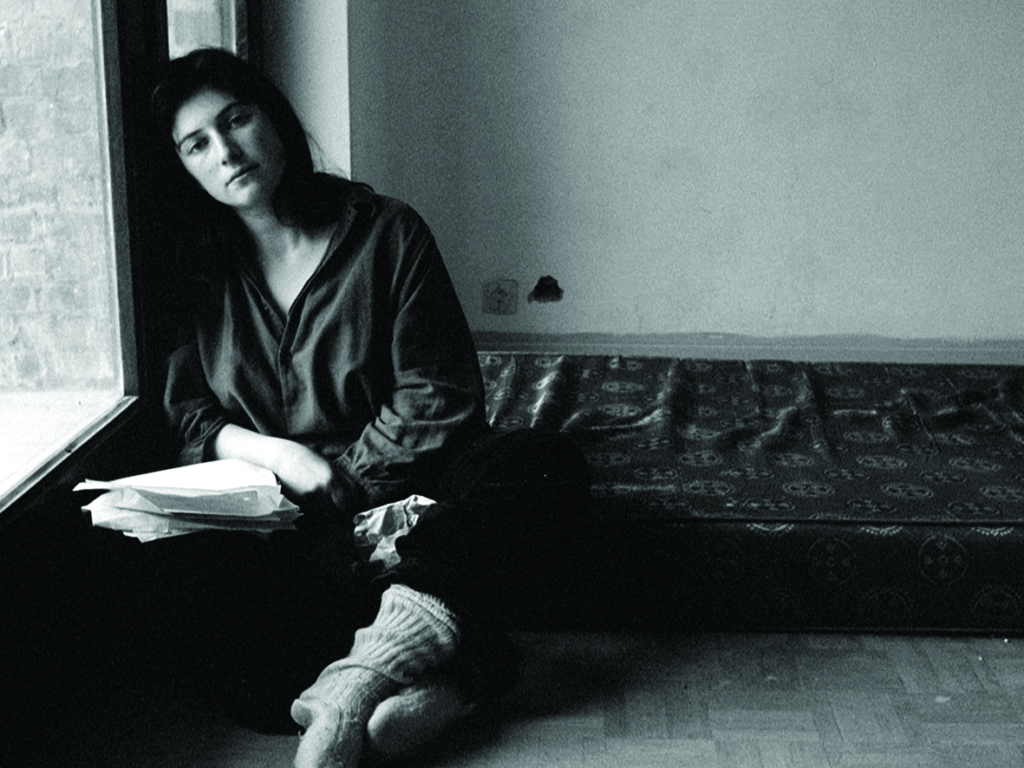
That these two new Australian underground (or, at least, in Lodkina’s case, underground-adjacent) directors should share a passion for the Belgian experimental filmmaker is not particularly surprising: Akerman has been a staple of film and gender studies courses for decades.[11]See Cristina Álvarez López & Adrian Martin, ‘Chantal Akerman: A Primer’, Sight & Sound, vol. 25, no. 2, February 2015, available at <https://www.bfi.org.uk/news-opinion/sight-sound-magazine/features/chantal-akerman-primer>, accessed 5 March 2019. But what, then, can we make of the near-complete absence of anything comparable to her work in the visible Australian film industry, either in terms of the radicalism of her specific aesthetics or, more generally, her bold experiments with form? It is important not to overstate the case here: European underground filmmakers, by and large, have faced plenty of struggles on their own for funding and recognition. But there is a distinction between niche and invisible, and the fact that Grace, Who Waits Alone remains undistributed and mostly unknown to Australian cinephiles over two years since its completion indicates that the contemporary industry has little space for anything so aesthetically radical.
The fact that Grace, Who Waits Alone remains undistributed and mostly unknown to Australian cinephiles over two years since its completion indicates that the contemporary industry has little space for anything so aesthetically radical.
For Temple, this is not a wholly unwelcome state of affairs. While she observes that ‘it’s pretty clear we have a pretty massive problem as an industry’ and doesn’t believe that industry bodies’ genre focus ‘results in better films’, she expresses a willingness to continue to remain outside the realm of the mainstream Australian film industry for the time being: ‘I would much rather try to make, basically, no-budget films and really hone my skills before I even start to think about funding.’[12]Temple, op. cit. Not all filmmakers working outside the establishment are quite as willing to make peace with this dynamic, however. Mike Retter, director of Youth on the March (2017),[13]This film is covered in an earlier issue of Metro; see Anthony Nocera, ‘Rebel on the Screen: Mike Retter on Youth on the March’, Metro, no. 197, 2018, pp. 28–33. has claimed in an interview that the script for his film (which he developed with fellow independent filmmaker Allison Chhorn) was rejected for funding on the grounds of ‘sexism’.[14]Mike Retter, quoted in Malcolm Sutton, ‘Political Correctness “Stifling Australian Cinema” as Indie Filmmakers Rebound in Adelaide’, ABC News, 24 March 2018, <https://www.abc.net.au/news/2018-03-24/political-correctness-stifling-australian-cinema-filmmaker-says/9571006>, accessed 5 March 2019. Retter’s diagnosis of the malaise surrounding mainstream Australian film is blunt: a ‘university elite point of view that does not reflect the rest of society’, which, he argues, forms part of a broader arts culture that is ‘monolithic, stagnant, safe and politically correct’.[15]ibid.

For nearly two decades, the most visible claim to the mantle of underground cinema in Australia has been the aforementioned MUFF, founded in 2000 by filmmaker Richard Wolstencroft after his feature Pearls Before Swine (1999) was rejected by the Melbourne International Film Festival.[16]Michelle Griffin, ‘Bad Reputation’, The Age, 26 June 2004, <https://www.theage.com.au/entertainment/movies/bad-reputation-20040626-gdy3sw.html>, accessed 5 March 2019. While the event has often attracted approbation for its controversial programming choices and Wolstencroft’s own far-right political sympathies,[17]See Tom Clift, ‘Melbourne’s [sic] Underground Film Festival Director Under Fire over a Homophobic Facebook Rant’, Junkee, 18 November 2017, <https://junkee.com/richard-wolstencroft-homophobic-post/135573>, accessed 5 March 2019. it provides an instance of a very different conceptualisation of the term ‘underground’, identifying itself far less with experimental or aesthetically radical filmmaking than with grindhouse cinema and outré political opinion. In his excoriating contemporaneous review of Pearls Before Swine, critic Adrian Martin described the festival as representing something that ‘has very little to do with radically queer cinema, experimental art or authentically anarchist politics’, describing the films in the program as, instead, ‘ultra-low budget genre exercises’ and ‘exploitation rather than underground fare’.[18]Adrian Martin, ‘Pearls Before Swine’, Film Critic: Adrian Martin,July 2000, <http://filmcritic.com.au/reviews/p/pearls_before_swine.html>, accessed 2 March 2019.
While it seemed at one time to have derived at least some cache from its branding – along with a deeper cultural desire to foster a cinema outside established channels – MUFF has always been dominated by, if not quite its founder’s self-proclaimed ‘transcendental fascism’,[19]See Gerard Henderson, ‘Intellectual Garbage, by David Irving’, The Age, 8 July 2003, <https://www.theage.com.au/opinion/intellectual-garbage-by-david-irving-20030708-gdw0bg.html>, accessed 5 March 2019. then certainly a form of aggressive libertarianism. In some ways, MUFF might be seen as a precursor to the emergence of the (particularly US) alt-right’s transgressive ‘underground’ online subculture that has flourished over the last decade[20]A subculture whose epicentre, online bulletin board 4chan, has been aptly described by Irish non-fiction writer Angela Nagle as ‘the lowest form of a vacuous, faux-ironic, sniggering moral imbecilism’; see Nagle, ‘Paleocons for Porn’, Jacobin, 22 February 2017, <https://www.jacobinmag.com/2017/02/paleocons-for-porn>, accessed 5 March 2019. and that has, while remaining broadly despised, derived self-declared mainstream legitimacy from the election of its political poster boy Donald Trump as US President in 2016.[21]See Nicky Woolf, ‘The “Alt-right” Thrives in Opposition. What Happens Now It’s the Establishment?’, The Guardian, 15 November 2016, <https://www.theguardian.com/us-news/2016/nov/15/alt-right-victory-donald-trump-mainstream-what-next>, accessed 5 March 2019. For MUFF, this inversion of the concept of ‘underground’ was perhaps finally solidified last year; its program featured a pro-Trump propaganda documentary directed by none other than former White House chief strategist Steve Bannon.[22]See ‘The Melbourne Underground Film Festival Returns for Its 19th Year’, Forté, 18 October 2018, <http://fortemag.com.au/?p=42434>, accessed 5 March 2019.
None of this is to suggest, of course, that politics ought to have no place in underground filmmaking. Chris Luscri – who executive-produced Youth on the March, is serving as co-producer on Courtin-Wilson’s upcoming film The Empyrean and has curated or co-curated a range of independent film programs – argues for the importance of underground works that contain an intersection of minority voices: both ‘minority as it pertains to class and also to film form, not merely the “top layer” (identity politics) that dominates a lot of leftist-liberalist discourse’. In his view, ‘the best films being made […] in this country at the moment are by filmmakers whose “minority status” sits across all three of those spheres’.[23]Chris Luscri, Facebook Messenger exchange with author, 21 February 2019.
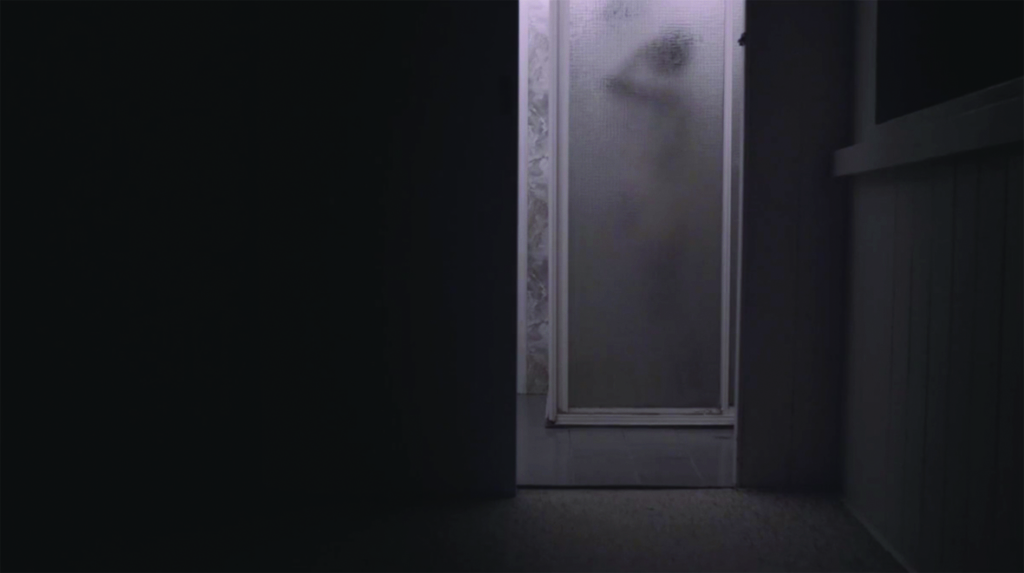
Political motivations were also not far away from the filming of Grace, Who Waits Alone, particularly regarding Temple’s decision to play the lead role: ‘[Acting] felt like me pushing myself to expose but also just to get rid of [concerns] that feel damaging to myself, as someone who wants to do art,’ she explains, describing the film as an attempt ‘to not allow those preoccupations to remain – because I feel like there are a lot of behaviours or concerns I hold because of conditioning’. She continues:
That act of putting oneself on screen in that kind of more open and unguarded way and then showing it to people is really terrifying. It does really just rid you of a lot of that. It’s really cathartic to do […] And maybe that’s why it’s common for a lot of female artists to want to do that, especially early on in their careers.[24]Temple, op. cit.
One recent film that effectively synthesises Luscri’s ‘spheres’ is Chhorn’s mid-length work The Plastic House (2018), a project that mirrors Grace, Who Waits Alone’s minimalism, intimacy and claustrophobia but adds a layer of documentary realism by depicting the director’s family members at work in an Adelaide greenhouse. Whereas, in Temple’s film, dialogue is nearly entirely confined to the director’s intermittent poetic voiceover, in Chhorn’s, the only voices we hear are her parents and uncle occasionally speaking in English-subtitled Khmer. In both films, repetitive manual labour is juxtaposed with physical and psychological isolation; in The Plastic House, that loneliness is derived from the director’s imaginative representation of what her life might be like after her parents’ death, a loneliness that she explicitly compares to the times she has been left in Australia to fend for herself without them.[25]Allison Chhorn, ‘The Plastic House: Director’s Statement’, Pure Shit: Australian Cinema, 16 November 2018, <http://www.pureshitauscinema.com/features/plastic_house.html>, accessed 5 March 2019.
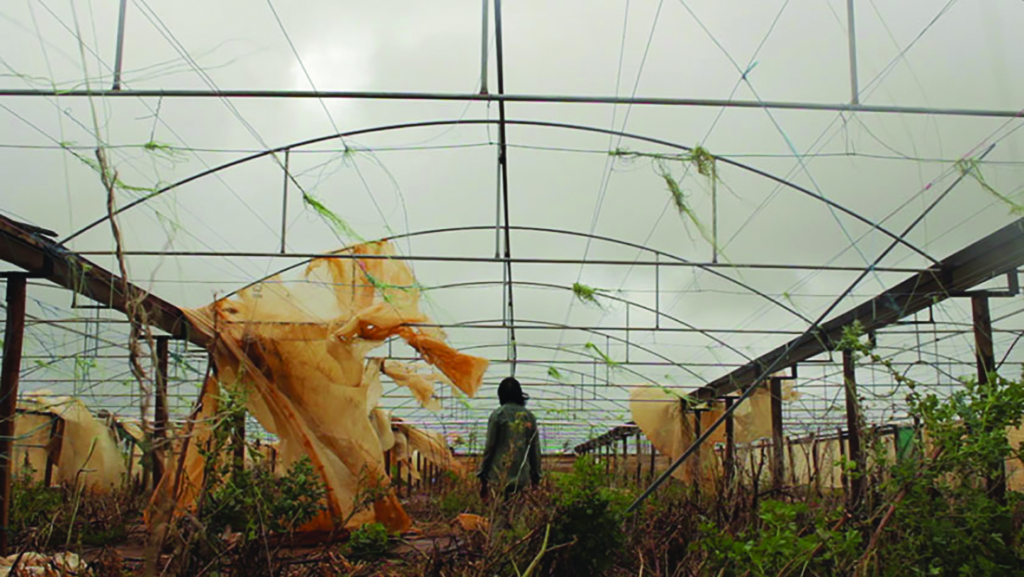
Perhaps, then, the loneliness that Chhorn and Temple allow themselves to navigate in their respective films serves as an apt metaphor for underground filmmaking in Australia. These are films that might not quite fill a thirty-seat makeshift cinema in Melbourne’s inner north, and it’s highly likely that they will remain undistributed, unavailable to all but a lucky few. But in their intimacy and careful composition, even with all of the technical and budgetary limitations their creators have had to contend with, they are as cinematically pure as any Palme d’Or winner or massive international co-production, and they speak a language as radical as the best of their underground antecedents. Don’t let anyone tell you that artistically ambitious Australian cinema is dead – you just have to know where to find it.
Endnotes
| 1 | Georgia Temple, video interview with author, 3 February 2019. |
|---|---|
| 2 | See Bill Mousoulis, ‘The Australian New Wave at Long Play, Melbourne, Nov 2018’, Pure Shit: Australian Cinema, 31 October 2018, <http://www.pureshitauscinema.com/new_wave_lp_18.html>, accessed 5 March 2019. |
| 3 | Bill Mousoulis, email interview with author, 3 March 2019. |
| 4 | ibid. |
| 5 | See Alex Gerbaz, ‘The Legacy of the Experimental Film and Television Fund, 1970–78’, paper presented at the National Archives of Australia, Canberra, 13 October 2009, available at <http://www.naa.gov.au/collection/publications/papers-and-podcasts/social-history/gerbax-transcript.aspx>, accessed 5 March 2019. |
| 6 | For a curated catalogue of some of these films, see Bill Mousoulis, ‘Online Indie Australian Cinema’, Pure Shit: Australian Cinema, <http://www.pureshitauscinema.com/online_cinema.html>, accessed 5 March 2019. |
| 7 | See Steve Dow, ‘What’s Wrong with Australian Cinema?’, The Guardian, 26 October 2014, <https://www.theguardian.com/film/2014/oct/26/australian-film-australian-audiences>, accessed 5 March 2019. |
| 8 | Mousoulis, email interview with author, op. cit. |
| 9 | Temple, op. cit. |
| 10 | Alena Lodkina, ‘Chantal Akerman and the Possibility of Intimacy in Film’, 4:3, 3 October 2016, <https://fourthreefilm.com/2016/10/chantal-akerman-and-the-possibility-of-intimacy-in-film/>, accessed 5 March 2019. |
| 11 | See Cristina Álvarez López & Adrian Martin, ‘Chantal Akerman: A Primer’, Sight & Sound, vol. 25, no. 2, February 2015, available at <https://www.bfi.org.uk/news-opinion/sight-sound-magazine/features/chantal-akerman-primer>, accessed 5 March 2019. |
| 12 | Temple, op. cit. |
| 13 | This film is covered in an earlier issue of Metro; see Anthony Nocera, ‘Rebel on the Screen: Mike Retter on Youth on the March’, Metro, no. 197, 2018, pp. 28–33. |
| 14 | Mike Retter, quoted in Malcolm Sutton, ‘Political Correctness “Stifling Australian Cinema” as Indie Filmmakers Rebound in Adelaide’, ABC News, 24 March 2018, <https://www.abc.net.au/news/2018-03-24/political-correctness-stifling-australian-cinema-filmmaker-says/9571006>, accessed 5 March 2019. |
| 15 | ibid. |
| 16 | Michelle Griffin, ‘Bad Reputation’, The Age, 26 June 2004, <https://www.theage.com.au/entertainment/movies/bad-reputation-20040626-gdy3sw.html>, accessed 5 March 2019. |
| 17 | See Tom Clift, ‘Melbourne’s [sic] Underground Film Festival Director Under Fire over a Homophobic Facebook Rant’, Junkee, 18 November 2017, <https://junkee.com/richard-wolstencroft-homophobic-post/135573>, accessed 5 March 2019. |
| 18 | Adrian Martin, ‘Pearls Before Swine’, Film Critic: Adrian Martin,July 2000, <http://filmcritic.com.au/reviews/p/pearls_before_swine.html>, accessed 2 March 2019. |
| 19 | See Gerard Henderson, ‘Intellectual Garbage, by David Irving’, The Age, 8 July 2003, <https://www.theage.com.au/opinion/intellectual-garbage-by-david-irving-20030708-gdw0bg.html>, accessed 5 March 2019. |
| 20 | A subculture whose epicentre, online bulletin board 4chan, has been aptly described by Irish non-fiction writer Angela Nagle as ‘the lowest form of a vacuous, faux-ironic, sniggering moral imbecilism’; see Nagle, ‘Paleocons for Porn’, Jacobin, 22 February 2017, <https://www.jacobinmag.com/2017/02/paleocons-for-porn>, accessed 5 March 2019. |
| 21 | See Nicky Woolf, ‘The “Alt-right” Thrives in Opposition. What Happens Now It’s the Establishment?’, The Guardian, 15 November 2016, <https://www.theguardian.com/us-news/2016/nov/15/alt-right-victory-donald-trump-mainstream-what-next>, accessed 5 March 2019. |
| 22 | See ‘The Melbourne Underground Film Festival Returns for Its 19th Year’, Forté, 18 October 2018, <http://fortemag.com.au/?p=42434>, accessed 5 March 2019. |
| 23 | Chris Luscri, Facebook Messenger exchange with author, 21 February 2019. |
| 24 | Temple, op. cit. |
| 25 | Allison Chhorn, ‘The Plastic House: Director’s Statement’, Pure Shit: Australian Cinema, 16 November 2018, <http://www.pureshitauscinema.com/features/plastic_house.html>, accessed 5 March 2019. |
